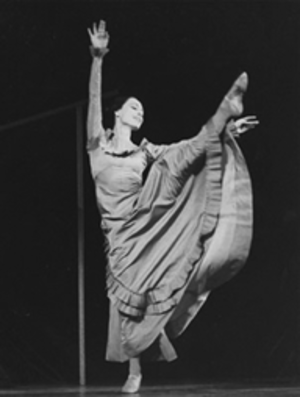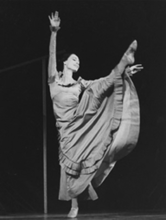Pearl Lang
Pearl Lang was the first dancer Martha Graham allowed to perform some of Graham’s roles and also brought elements of the ecstatic poetry and dance of Jewish traditions to her own praised work. Lang grew up with a love of Yiddish poetry, theater, and dance and joined Martha Graham’s company at age twenty. Lang took on most of Graham’s leading roles and became known as the great interpreter of Graham’s work. In 1953, she formed her own company with Graham’s blessing, choreographing and directing pieces based on Jewish plays, poetry, and legends. She also accepted commissions from other dance companies and at Yale, Juilliard, and the Martha Graham School. She was awarded two Guggenheim Fellowships and continued choreographing and teaching throughout her life.
In the world of modern dance, Pearl Lang holds two distinctions. As one of Martha Graham’s most expressive soloists, she was the first dancer to perform some of Graham’s own roles. As the “poetess of the Lit. (Greek) "dispersion." The Jewish community, and its areas of residence, outside Erez Israel.Diaspora and the Holocaust,” Lang was also a choreographer and performer passionately attached to her Jewish heritage.
Early Life and Family
She was born Pearl Lack, the daughter of Freida (Feder) and Jacob Lack, on May 29, 1921, in Chicago. Both her parents were Russian Jews, her mother having been born in Pinsk, and her father near Vilna. Her father, a tailor, died when she was seven years old. Lang had one brother, who later became a doctor.
In Pearl’s socialist, working-class family, music, theater, and poetry were integral to the daily routine. Her father played piano, her mother wrote poetry, and both actively participated in Chicago’s Jewish cultural societies. Yiddish was the first language in the household. Pearl would be powerfully influenced not only by her family’s Jewish heritage but also by the cultural riches of Chicago. She learned English with her mother at night school and at Hibbard Elementary School, which offered classes integrating art, literature, history, and geography. Not surprisingly, her own interest in artistic activities began early. Freida Lack took her children to operas such as Hansel and Gretel and A Midsummer Night’s Dream, to the Chicago Symphony’s children’s concerts, and to modern dance performances.
If there was a defining moment in Pearl’s life, it would have occurred during a performance by the Duncan Dancers, the adopted daughters of Isadora Duncan, which took place at Chicago’s Orchestra Hall. Three-year-old Pearl watched as one of the Duncan dancers, dancing to a Russian song, skipped from the back of the stage to the front, opening her arms and appearing to fill the theater with a cascade of light. At that point, Pearl states that she recognized the dancer’s rebellious and independent spirit as her own.
At age ten, she choreographed her first dance—about the flooding of the Nile River—for one of her classes. After-school and weekend classes at the Workmen’s Circle, a Yiddish school, provided her with additional drama, dance, and music instruction. When she was sixteen, she made her public debut at a Chicago opera house, choreographing and performing a group dance with fellow students to the first movement of Mozart’s Eine Kleine Nachtmusik.
New York and Early Career
In high school, while studying with Frances Allis, she started her own dance company. She performed a solo work for the Chicago choreographer Ruth Page as part of the Work Projects Administration program and watched performances by the prominent modern dancers of the time: Martha Graham, Hanya Holm, Doris Humphrey, Harold Kreutzberg, and Charles Weidman. In the summer of 1941, she convinced her mother to let her study with Martha Graham. She went to New York, and within a few months, she became a member of Graham’s famous company. In her first performance with the company, she danced in Letter to the World, based on the poetry of Emily Dickinson. In the same year, she performed a solo and a duet with Erick Hawkins in the premiere of Punch and Judy. Soon after, she danced in the Graham classic Deaths and Entrances, about the Brontë sisters, and in Appalachian Spring. It was also during this time that her last name was changed. Graham and the influential dance critic John Martin felt the young dancer needed a more appropriate stage name. Over her objections, Pearl Lack became Pearl Lang.
To support herself in New York, she performed in Broadway musicals, including Carousel and Finian’s Rainbow, as well as in plays by Kurt Weill and S.J. Perelman. She also played Solveig opposite John Garfield in Peer Gynt, directed by Lee Strasberg. To Lang, these were merely jobs; her artistic self belonged to the Martha Graham Company, with whom she performed off and on from 1941 to 1978. She eventually took over many of Graham’s leading roles—in Primitive Mysteries, El Penitente, Letter to the World, Herodiade, Night Journey, Clytemnestra, and Appalachian Spring—making a name for herself as the premier interpreter of the great artist’s work.
Lang’s Work and Jewish Themes
In 1953, Lang formed her own company. Martha Graham encouraged her new venture and gave her money to hire a composer when she decided to choreograph the famous Jewish play The Dybbuk. The first piece that Lang choreographed for her new troupe was a duet for two women called Song of Deborah. She later revised the work and presented it with the New York Philharmonic in 1956 as part of the annual Israel Bonds Lit. "dedication." The 8-day "Festival of Lights" celebrated beginning on the 25th day of the Hebrew month of Kislev to commemorate the victory of the Jews over the Seleucid army in 164 B.C.E., the re-purification of the Temple and the miraculous eight days the Temple candelabrum remained lit from one cruse of undefiled oil which would have been enough to keep it burning for only one day.Hanukkah Festivals, an event she choreographed for and performed in for five years.
Lang’s choreography has been praised for its drama and poetry. Its “ecstatic” style of movement and ability to portray passionate feelings is striking. Lang claims that her work comes from a “hassidic” impulse: “Through ecstatic dance, one is lifted nearer to God.” As a performer, Lang has been described as a dancer of “speed and ecstasy” and one of the most lyrical performers in American dance. “Grace and strength are united in her natural dynamic,” declared the New York Times. A review in the Village Voice called Lang “one of the few dancers it is safe to call great.” Lily Rosen in Dance News and the Jewish Journal stated, “The choreography of Lang never fails to touch secret places in our hearts.”
Lang has choreographed fifty works. More than half have Jewish themes, ten of which are set to Sephardi songs and prayers with Spanish, Greek, and Moroccan influences. Key works include The Dybbuk [Possessed], based on the Yiddish play by Ansky; I Never Saw Another Butterfly, based on poems written by children who died at Theresienstadt and on biblical songs, Tongues of Fire, inspired by prophetic writing; and three programs of dances based on Yiddish poetry. Moved by the suffering of Jews during World War II, Lang choreographed And Again a Beginning, Lit. (Aramaic) "holy." Doxology, mostly in Aramaic, recited at the close of sections of the prayer service. The mourner's Kaddish is recited at prescribed times by one who has lost an immediate family member. The prayer traditionally requires the presence of ten adult males.Kaddish and Two Poems of the Holocaust.
Shira [Song], set to the music of Alan Hovhaness, is Lang’s signature piece. It embodies the hassidic parable that inspires the artist. The parable, attributed to Rabbi Nachman of Bratzlav, reads: “At the end of the world stands a high mountain, and from it flows a spring. At the opposite end is the heart of the world. The heart of the world keeps the spring ever in sight. If for one moment, it loses sight of the spring, it loses, in the same moment, its life.”
Later Career and Legacy
Lang remained a busy choreographer and teacher for many years. Dance companies that commissioned her work include the Netherlands National Ballet, the Batsheva Dance Company of Israel, the Repertory Dance Theater of Utah, and the Boston Ballet. She choreographed dances for theatrical productions, including Oedipus Rex with Seiji Ozawa and the Boston Symphony, and plays at the Shakespeare Festival and the Yale Repertory Theater. Lang also instructed directors and actors at Yale University and performers at the Juilliard School, as well as serving on the faculty of the Martha Graham School of Contemporary Dance in New York City.
While co-directing a version of The Dybbuk for the Canadian Broadcasting Company, she met her future husband, actor Joseph Wiseman. They married in 1964. Both Lang and Wiseman are well-known performers of Yiddish poetry.
Her long list of honors includes two Guggenheim Fellowships, the Martha Graham Award for Performance and Choreography, and six awards from the Jewish community, including the Workman’s Circle Award (an achievement award from Artists and Writers for Peace in the Middle East) and the National Foundation for Jewish Culture Annual Cultural Achievement Award for 1992. In May 1995, she received an honorary Doctor of Fine Arts degree from the Juilliard School. Lang continued to teach modern dance technique and choreography in New York for many years.
Pearl Lang died on February 24, 2009.
De Mille, Agnes. The Life and of Work of Martha Graham (1956)
Stodelle, Ernestine. Deep Song: The Dance Story of Martha Graham (1984)
Tobias, Tobi. Interview with Pearl Lang. Dance Collection Oral History Project, New York Public Library, 1975 and 1979.







